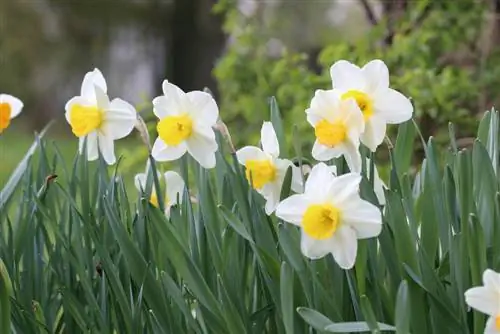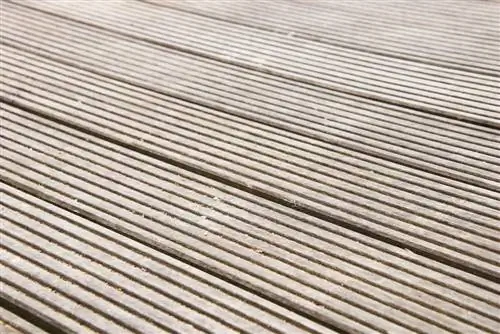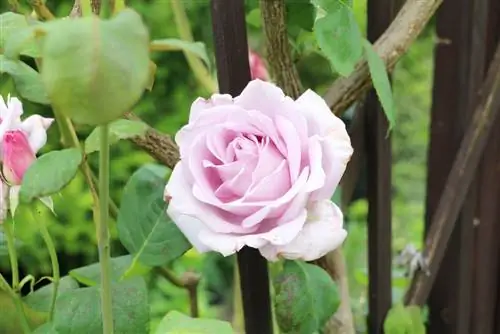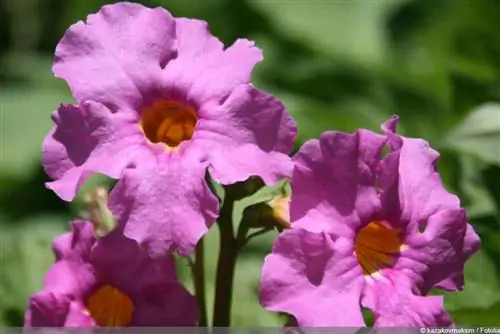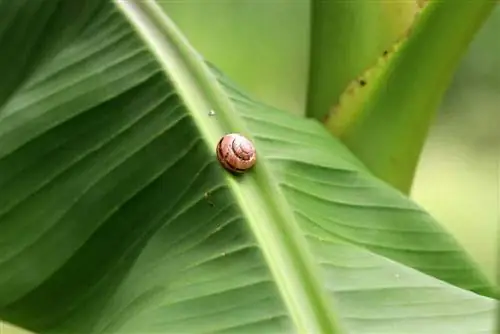- Author admin [email protected].
- Public 2023-12-17 03:39.
- Last modified 2025-06-01 06:48.
Daffodils prefer moist soil and can thrive not only in beds, but also on the lawn in the garden and provide colorful accents in sunny yellow.
Planting daffodils - this is what you need to consider
Daffodils and daffodils are bulbous plants. They can be planted in small groups or solitary in the garden. When choosing a location, it is important to choose a place with moist soil and sun to partial shade. The daffodil does not appreciate a consistently shady location and only reaches a small height and does not always produce one inflorescence. Many gardeners plant daffodils together with tulips and look forward to a colorful spring meadow. However, this combination of planting is not ideal because daffodils and daffodils require higher soil moisture than tulips and other bulbous plants. Since daffodils and daffodils are mostly planted in groups, the gardener should follow these instructions and ensure there is enough space for each individual plant:
- Plant spacing at half the growth width
- Planting depth is three times the size of the bulb
- choose a sunny location with soil moisture
- do not use soil that is waterlogged
- do not use lime or nitrogen-containing soil
Since daffodils and daffodils also grow wild in parks or meadows, it can be assumed that they are very undemanding and appear in new blooms every spring, even without intensive care. However, there are different varieties of these onion plants, which have different care requirements. Not every daffodil can simply be planted in the meadow and left to the influence of natural conditions. Especially in summer, a location that is too wet can cause the bulbs to rot and prevent them from blooming again next spring.
Care instructions for the yellow flowers in the garden
If the gardener decides to have daffodils and daffodils in the house or on the balcony, it is widely believed that they only bloom once in this location. The plants are not an annual variety, but simply the wrong place in the apartment and insufficient climatic conditions. To ensure that the daffodil continues to bloom next year, it can be given a permanent location in the garden after it has bloomed in the flower pot or balcony box. By releasing it into the wild, the bulb does not wither and the plant has the chance to delight the gardener with full blooms for several years. Daffodils and daffodils are not always the same. Only the yellow trumpet-shaped daffodil is called daffodil. Proper care of these early bloomers begins with the choice of location. As a result of planting in the garden you should:
- prefer a sunny and weather-protected place
- water the bulbs sufficiently after planting in the ground
- water regularly and do not let it dry out during the flowering phase
- remove spent shoots with a sharp knife
- Don't pick cut flowers for the vase, but cut them too
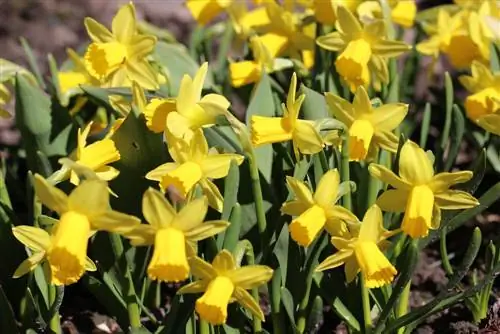
The undemanding plant is suitable for all gardeners who prefer a colorful spring meadow or want to add a decorative accent to the garden bed. Since the maintenance effort is very low, daffodils and daffodils do not require a lot of time to achieve maximum bloom. What is particularly important is that sensitive varieties prefer to overwinter indoors. However, most daffodil species can remain indoors without any special preparation or overwintering and can grow in the same location next spring with the same flowers.
Charming early bloomers in the vase
The daffodil is even more popular than in the garden when it is tied into a bouquet and ushers in spring in the house. As with planting in the garden, these flowers should not be tied together with tulips in a bouquet. It is not the fully developed inflorescences that are used for the bouquet, but rather the buds that are still tightly closed. Since the flowers open very quickly in a warm room and flowers that have already opened fade quickly, this strategy has become popular for daffodils in the vase. Unknown to many gardeners, the daffodil exudes a subtle and barely perceptible scent. In nature it is hardly noticeable due to its subtle structure, but in the vase it will fill the room and usher in spring.
What you should know about daffodils in brief
If gardeners do not opt for one of the more sensitive varieties or dwarf forms that are difficult to care for in this latitude, there is no great effort required when it comes to caring for the plants, overwintering or propagating them. Most of the daffodil species offered here are ideal for planting in European gardens and do not need to be cut back or brought indoors over the winter. They bloom for several years in the location where they were planted as young bulb plants.
There are two options for planting daffodils in the garden: On the one hand, the gardener can choose bulbs, but he can also choose small young plants. The bulbs are preferably planted in autumn, as they will bloom in the first spring. If you don't plant daffodils until spring, you should choose a young plant that is already blooming and not choose pure bulbs. Since onion plants often fall victim to small rodents or animals digging in the garden, the planting depth should not be too minimal. Three times the depth of the onion size is recommended and should not be less than this. However, placing them too deep in the ground is not an advantage and can result in the gardener waiting in vain for the daffodils to sprout in the spring.
Tip:
Daffodils should not be missing from any natural garden, but be careful: all parts, especially the bulb itself, are poisonous!
Daffodils - varieties
The most common variety is probably the trumpet-shaped Narcissus fortune, the daffodil. Double flowers are particularly beautiful, but they also become heavy and can break off after heavy rain or strong winds. Particularly worth mentioning here is the yellow-orange Orange Phoenix, which was not bred by humans but by nature itself. We are particularly pleased early, at the end of February/beginning of March, with the yellow February Gold and the creamy white Narcissus cyclamineus 'Jack Snipe', which can hardly be surpassed in terms of abundance of flowers, longevity and vigor.
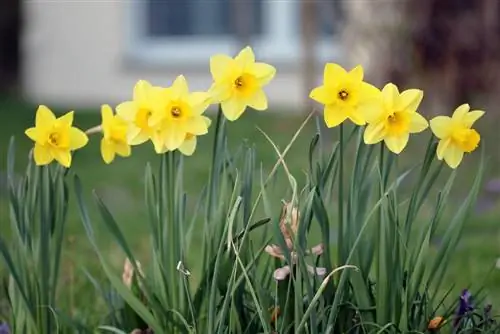
There are also some strongly scented species, such as the white 'Cheerfulness White', the yellow 'Cheerfulness Yellow', 'Sir Winston Churchill' or the white-flowering Narcissus poeticus with a red-yellow “core”. Actaea. The Narcissus jonquilla, which blooms in April with 2-6 flowers per style, has an orange-like scent. It is very spreading.
Daffodils in the rock garden / herbaceous beds
Daffodils are real eye-catchers in front of trees and in rock gardens in the otherwise rather bare spring. They are often planted in lawns because they are usually gone when the lawn starts to grow again and needs to be mowed. But they also look great in dull perennial beds, as they bloom before most others. When the first shoots of the perennials come out in spring, the daffodils have usually already bloomed and therefore do not form any competition. The new shoots of the perennials cover the daffodil leaves, which are no longer so beautiful after a while but are important. Withered flowers can be removed as well as the stems; the leaves should remain on the bulb until they wilt, as they allow the bulb to absorb vital nutrients and water in order to be able to bloom successfully again next year.
Daffodil Society
Daffodils love the company of similar varieties and are also good partners with daisies, grape hyacinths and tulips. Although they can also be used as cut flowers, they do not mix well with other flowers because they contain a poison. So before you put them in a vase with other flowers, they should stand alone in water for 24 hours so that the poison is washed out. But then don't cut it again, otherwise it will take another 24 hours! If you don't want to wait that long, you can also add a piece of charcoal to the water, which neutralizes the poisonous effects of the juice.

